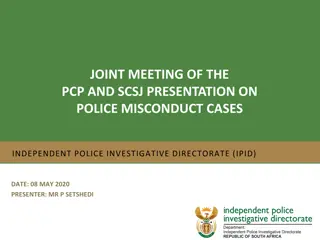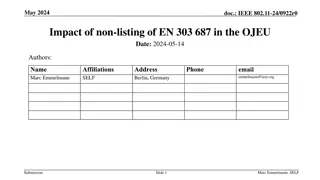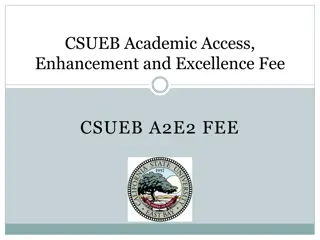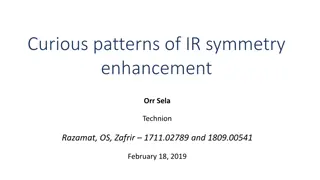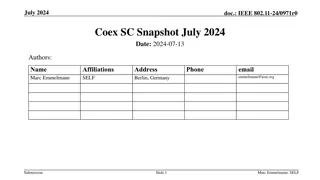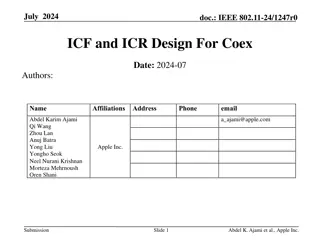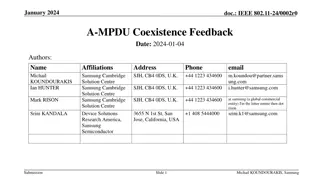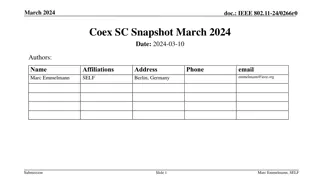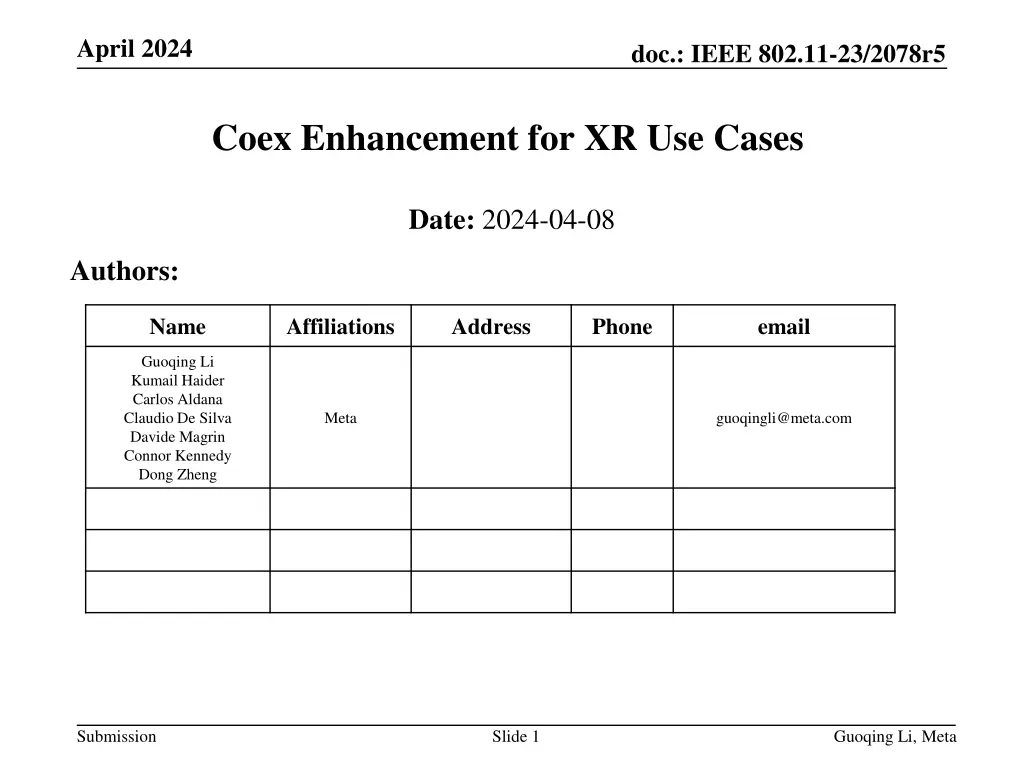
IEEE 802.11-23/2078r5 Coexistence Enhancement for XR Devices
Explore the IEEE 802.11-23/2078r5 document focusing on enhancing coexistence for XR devices utilizing multiple radios like Wi-Fi and Bluetooth. Addressing issues such as RF component sharing, time-sharing RF resources, and potential interference between different radio signals. The proposal aims to define mechanisms allowing devices to manage coexistence challenges effectively.
Download Presentation

Please find below an Image/Link to download the presentation.
The content on the website is provided AS IS for your information and personal use only. It may not be sold, licensed, or shared on other websites without obtaining consent from the author. If you encounter any issues during the download, it is possible that the publisher has removed the file from their server.
You are allowed to download the files provided on this website for personal or commercial use, subject to the condition that they are used lawfully. All files are the property of their respective owners.
The content on the website is provided AS IS for your information and personal use only. It may not be sold, licensed, or shared on other websites without obtaining consent from the author.
E N D
Presentation Transcript
April 2024 doc.: IEEE 802.11-23/2078r5 Coex Enhancement for XR Use Cases Date: 2024-04-08 Authors: Name Affiliations Address Phone email Guoqing Li Kumail Haider Carlos Aldana Claudio De Silva Davide Magrin Connor Kennedy Dong Zheng Meta guoqingli@meta.com Submission Slide 1 Guoqing Li, Meta
April 2024 doc.: IEEE 802.11-23/2078r5 Problem Statement XR devices may use multiple radios such as Wi-Fi and Bluetooth and need to coex well Device constraint issue Due to size and cost, these radios may share RF components and have to time share the RF resources Due to possible low isolation, one radio s Tx may destroy another radio s Rx In addition, Tx+Tx or Rx+Rx may not be possible depending on device s architecture design and cannot be assumed as default AP rate adaptation issue BT traffic interval may be at a few ms (<10ms) and Wi-Fi may not have sufficient time to notify AP its unavailability using power save signaling (e.g., PM) when switching to BT activity As a result, downlink throughput/latency may be greatly degraded from AP s fast rate scaling down due to lack of response from STA Wi-Fi packet duration issue BT typically has periodic traffic and need to Tx/Rx at predicted time slot However, AP/STA may continue Tx into BT s Tx/RX slot, leading to either Wi-Fi packet loss or BT packet loss Slide 2 Submission Guoqing Li, Meta
April 2024 doc.: IEEE 802.11-23/2078r5 Coex Enhancement A client (STA) device may be aware of its co-located traffic profile from other technologies (e.g., BT) and traffic interval and may shape its Wi-Fi Tx/Rx traffic to fit into non-overlapping intervals STA may be able to control its uplink Tx activity, but has not mechanism to control AP s DL activity Proposal Define a mechanism that allows STA to indicate to AP periods of potential unavailability due to coex issues Define a mechanism that allows STA to request AP to control the following Max DL packet duration Min Tx interval Modified/slow DL rate control upon missing UL BA BT (or other tech.) activity usually will last a few seconds to minutes, thus these parameters can be negotiated through management frames Submission Slide 3 Guoqing Li, Meta
April 2024 doc.: IEEE 802.11-23/2078r5 STA Indication of coex activity STA devices typically have good estimation of traffic profile of coex technologies These traffic profiles tend to have periodic, predictable intervals and data rates (channel usage duration requirements) E.g., a BT use case may be invoked such as audio streaming, leading to Xms BT usage every CI (e.g., 10 ms) A STA may proactively share this coex schedule with the AP At the minimum, coex activity duration and interval (and possibly future end time) may be shared (existing methods may be discussed, or new methods may be devised) STA may also indicate frequency/spatial resources if coex operation partially impacts Wi-Fi availability/operation AP may modify its operation for the STA based on coex info (e.g., always use RTS/CTS before DL TX, modify rate adaptation, modify freq. resource allocations etc. during periods of coex activity) Submission Slide 4 Guoqing Li, Meta
April 2024 doc.: IEEE 802.11-23/2078r5 BA agreement modification to control DL duration A client (STA) device may use DL BA agreement to influence the DL packet duration For example, tear down BA agreement/disable A-MPDU for DL transmission to reduce DL PPDU duration However, there is lack of mechanisms (or limitations) for STA to trigger the re-setup of DL BA Propose to define a mechanism for STA to prompt AP to set up DL BA agreement or to modify DL BA agreement in an unsolicited manner Submission Slide 5 Guoqing Li, Meta
April 2024 doc.: IEEE 802.11-23/2078r5 Proposed Spec Changes Define management frame(s) to Indicate that STA allows STA to indicate to AP periods of potential unavailability/constrained operation due to coex issues Indicate STA s coex requirements for DL transmission Modified rate adaptation during coex periods Max PPDU duration Min Tx interval Allows STA to prompt AP to modify/setup DL BA Submission Slide 6 Guoqing Li, Meta


